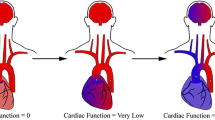Abstract
Although venoarterial extracorporeal membrane oxygenation (VA-ECMO) was widely used in clinical practice, the effects of cardiac output on the aortic oxygen distribution were still unclear. Hence, the present study aims to evaluate the effect of cardiac function on the aortic oxygen distribution under VA-ECMO support. A novel model, combining computational fluid dynamics, multiphase fluid approach, and oxygen transport theory together, was established. According to the clinical practice, four cardiac output conditions, including 0, 1, 2, and 2.5 L/min, were designed. The results demonstrated that the proposed method could accurately calculate the distribution of oxygen in the aorta. Moreover, the aortic oxygen distribution was significantly regulated by the local blood flow pattern. The deoxygenated blood flow and oxygenated blood flow met at the aortic arch and formed the so-called oxygenshed phenomenon. Along with the cardiac output increase, the oxygenshed was moved from the proximal of the aortic arch to the descending aorta. Meanwhile, the oxygen contents in the brachiocephalic artery and left common carotid artery were reduced along with the increase of cardiac output. The study could provide much useful information on the oxygen distribution in the aorta to surgeons and operators of VA-ECMO.

The results showed the deoxygenated blood and oxygenated blood met at the aortic arch and formed the so-called “oxygenshed” phenomenon. This phenomenon is consistent with the phenomenon called “watershed”







Similar content being viewed by others
References
Extracorporeal Life Support Organization (2013) Extracorporeal life support registry report: international summary. Ann Arbor, ELSO
Avgerinos DV, DeBois W, Voevidko L, Salemi A (2013) Regional variation in arterial saturation and oxygen delivery during venoarterial extracorporeal membrane oxygenation. J Extra Corpor Technol 45(3):183–186
Hou X, Yang X, Du Z, Xing J, Li H, Jiang C, Wang J, Xing Z, Li S, Li X, Yang F, Wang H, Zeng H (2015) Superior vena cava drainage improves upper body oxygenation during veno-arterial extracorporeal membrane oxygenation in sheep. Crit Care 19(1):68. https://doi.org/10.1186/s13054-015-0791-2
Messai E, Bouguerra A, Harmelin G, di Lascio G, Bonizzoli M, Bonacchi M (2016) A numerical model of blood oxygenation during veno-venous ECMO: analysis of the interplay between blood oxygenation and its delivery parameters. J Clin Monit Comput 30(3):327–332. https://doi.org/10.1007/s10877-015-9721-8
Moore JA, Ethier CR (1997) Oxygen mass transfer calculations in large arteries. J Biomech Eng 119(4):469–475. https://doi.org/10.1115/1.2798295
Liu X, Fan Y, Deng X (2010) Effect of spiral flow on the transport of oxygen in the aorta: a numerical study. Ann Biomed Eng 38(3):917–926. https://doi.org/10.1007/s10439-009-9878-8
Liu X, Fan Y, Deng X, Zhan F (2011) Effect of non-Newtonian and pulsatile blood flow on mass transport in the human aorta. J Biomech 44(6):1123–1131. https://doi.org/10.1016/j.jbiomech.2011.01.024
Wen J, Liu K, Khoshmanesh K, Jiang W, Zheng T (2015) Numerical investigation of haemodynamics in a helical-type artery bypass graft using non-Newtonian multiphase model. Comput Methods Biomech Biomed Engin 18(7):760–768. https://doi.org/10.1080/10255842.2013.845880
Ou C, Huang W, Yuen MM et al (2016) Hemodynamic modeling of leukocyte and erythrocyte transport and interactions in intracranial aneurysms by a multiphase approach. J Biomech 49(14):3476–3484. https://doi.org/10.1016/j.jbiomech.2016.09.017
Lyczkowski RW, Alevriadou BR, Horner M, Panchal CB, Shroff SG (2009) Application of multiphase computational fluid dynamics to analyze monocyte adhesion. Ann Biomed Eng 37(8):1516–1533. https://doi.org/10.1007/s10439-009-9729-7
Hufner CG (1902) Neue versuche zur bestimmung der sauerstoff-capacitat der blutfarbstoffs. Arch Physiol 17:130–176
Hoeper MM, Tudorache I, Kühn C et al (2014) Extracorporeal membrane oxygenation watershed. Circulation 130(10):864–865. https://doi.org/10.1161/CIRCULATIONAHA.114.011677
Gu K, Zhang Y, Gao B, Chang Y, Zeng Y (2016) Hemodynamic differences between central ECMO and peripheral ECMO: a primary CFD study. Med Sci Monit 22:717–726. https://doi.org/10.12659/MSM.895831
Moisan M, Lafargue M, Calderon J, Oses P, Ouattara A (2013) Pulmonary alveolar proteinosis requiring “hybrid” extracorporeal life support, and complicated by acute necrotizing pneumonia. Ann Fr Anesth Reanim 32(4):e71–e75. https://doi.org/10.1016/j.annfar.2013.02.013
Chung M, Shiloh AL, Carlese A (2014) Monitoring of the adult patient on venoarterial extracorporeal membrane oxygenation. Sci World J 2014:393258
Funding
This work was partly sponsored by the National Natural Science Foundation of China (grant nos. 11602007, 91430215, 11572014) and BJUT Foundation Fund (grant no. 015000546317505).
Author information
Authors and Affiliations
Corresponding authors
Rights and permissions
About this article
Cite this article
Zhang, Q., Gao, B. & Chang, Y. The numerical study on the effects of cardiac function on the aortic oxygen distribution. Med Biol Eng Comput 56, 1305–1313 (2018). https://doi.org/10.1007/s11517-017-1777-9
Received:
Accepted:
Published:
Issue Date:
DOI: https://doi.org/10.1007/s11517-017-1777-9




